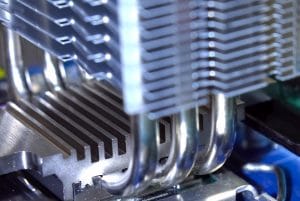 While heat exchangers have provided advanced electrical cooling for companies in various forms for decades, some solutions have proven more effective for the more common electrical cooling concerns that companies often have. For example, one of the earliest forms of modern heat exchangers included the use of highly efficient heat pipes, which are designed to facilitate the more streamlined process of transferring electrical waste heat that modern heat exchangers are based on. Today, heat pipes continue to prove one of the more effective methods of transferring heat, particularly custom-designed heat pipe assemblies that are made to perform specifically within a given application’s operating parameters.
While heat exchangers have provided advanced electrical cooling for companies in various forms for decades, some solutions have proven more effective for the more common electrical cooling concerns that companies often have. For example, one of the earliest forms of modern heat exchangers included the use of highly efficient heat pipes, which are designed to facilitate the more streamlined process of transferring electrical waste heat that modern heat exchangers are based on. Today, heat pipes continue to prove one of the more effective methods of transferring heat, particularly custom-designed heat pipe assemblies that are made to perform specifically within a given application’s operating parameters.
What heat pipes accomplish for modern technologies
Heat exchangers such as heat pipe assemblies transformed the way companies typically approach thermal management by introducing more efficient ways to achieve high-performance electrical cooling. They accomplished this by eliminating the need for chilled air that burdened more conventional cooling solutions, such as air conditioners. For example, within a heat pipe assembly, an eco-friendly cooling fluid is contained within the metal pipes and is able to absorb electrical waste heat at a rapid pace. The construction of the heat pipes allows the fluid to transfer the heat that it collects away from sensitive electrical components, preventing it from causing damage.
When electrical cooling is streamlined
Electrical cooling has always been a concern for companies’ overall efficiency and productivity. Before more advanced cooling methods, however, it was often a burden, and one that companies had to endure to keep their technology running properly. With advent of electrical heat transfer capabilities, heat exchangers made electrical cooling much less burdensome, often in the form of modern heat pipe assemblies. By harnessing the ability of an eco-friendly cooling fluid to absorb and transfer heat, heat pipes and other heat exchangers helped companies significantly reduce the overall costs, energy needs, and other considerations that go into electrical thermal management.
When heat pipe assemblies are customized
By streamlining the core processes of electrical cooling, modern heat pipe assemblies have given companies a significant advantage in adopting other advanced forms of technology. Transferring waste heat requires significantly less energy and the nearly self-contained operations of heat exchangers make them much more efficient at operating for extended periods of time. Yet, the benefits of streamlined electrical cooling are made even more profound when companies utilize custom-designed heat pipe assemblies that are made to fit into and perform according to each application’s specific parameters. For more information about how heat pipes help improve performance, call Noren Custom Thermal Solutions in Taylor, TX, at 866-936-6736.



